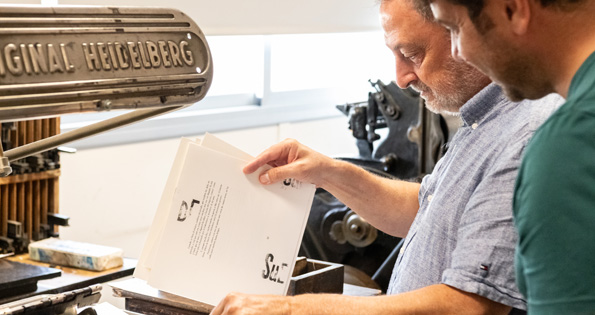Treasures of the UPV
Antonio Alcaraz, twice winner of the national prize, keeps printing with movable type alive in his shrine to the history of printing
[ 18/09/2023 ]
Last May, after analyzing a total of 154 works, the Ministry of Culture awarded the National Prize for the Best Published Book in 2022 to La vida de Lazarillo de Tormes y de sus fortunas y de sus adversidades, directed and designed by the Universitat Politècnica de València (UPV) Drawing Department lecturer Antonio Alcaraz together with the extraordinary printer and typographer Antonio Navarro.
The award, of undoubted prestige in the field of the author's book, is not the first to be won by a duo that met in the year 2000, when Alcaraz made personal contact with Navarro after being impressed by his visit to the centenary exhibition of the graphic work of the master printer from Sagunto.
It was then that the two began a collaboration that has not only brought them numerous awards - their work Las Fábulas literarias de Tomás de Iriarte, published by El Caballero de la Blanca Luna, won the same award in 2008, as well as the Prize for the Best Valencian Book 2007/2008 - but which, even today, brings them together in the small shrine created by Alcaraz in the Faculty of Fine Arts of the UPV, a room of just over 40 square meters that transports the visitor to the pre-digital printing era, with wooden drawers full of the movable type of all sizes and typographic variants, and dominated by majestic printing presses of the last century, including the 1955 Heidelberg rotary blade press on which the award-winning work was printed.
Alcaraz's admiration for Navarro is undisguised. "We have been collaborating for more than 20 years and he, at 85, is very keen to work, to come here to teach young people, to collaborate with us," says the UPV professor. "He has a table at the back, with his lamp, lamp stand, hanger... And he comes and sets up there and starts to compose. Then, we work with this machine, with the Heidelberg, which he handles with his eyes closed. He knows it very well because it's the one he used to work with in the printing house, and he knows it very well. So, we made a tandem that has worked... He brings his mastery, his know-how with the printing press, and we bring innovation, complicating his life (he laughs), of now you're going to mix this letter with this one, things that he didn't normally do... and it has worked".
The origin of the sanctuary
"The origin of all this? Yes, in principle it's me," Alcaraz explains humbly. "I started with another colleague, who has now retired. We used the letter as a complementary material in the woodcut part, wood engraving, because the form of printing is the same; it is a relief printing. So, at first, we put it in the class where we did the wood engraving, and then, little by little, we realized that it could come out of that lab and have its importance. So we started looking for old printing presses. At first we did it ourselves, but now the printers track us down and say, 'Hey, I have a machine,' but there's no room for us here anymore. I have another project in mind, which the Vice-Rectorate knows about, and if we could do it at some point, we could continue to bring in material from Valencian printers and put it together here at the UPV, but we need space. There's no more room here (he laughs again), there's no more room...", he repeats with a smile.
A passion that is transmitted
For Alcaraz, who takes great care with each creation - this limited edition of 80 copies has taken him three years of work ("they are books that, on a commercial level, nobody can consider"), he has already presented the book at Arts Libris, the leading national artists' book fair, and intends to "take it wherever I can think of, to Mexico, to Germany..." - the main objective is, in any case, to continue transmitting his passion to the new generations.
"It's not just about having the material," he says, "it's about learning how to use these machines, teaching our students to work with movable type...". The printing system is very peculiar, very different from everything done now, mostly digital printing. It has several aesthetic and technical characteristics that make it extraordinary. So, if we can get young people hooked on this technology, we can prevent it from being lost.
Outstanding news
 ARWU 2023
ARWU 2023
The Shanghai ranking reaffirms the UPV as the best polytechnic in Spain for yet another year
 Science Meets Regions CV 2023
Science Meets Regions CV 2023
The UPV and the Almussafes City Council begin a collaboration in search of solutions to maintain the automobile sector in the Valencia Region
 Scientific reference
Scientific reference
Avelino Corma, Distinguished Research Assistant at the UPV, awarded an Honorary Doctorate by the University of Huelva
 Micronanofabs NTC UPV-PERTE CHIP Conference
Micronanofabs NTC UPV-PERTE CHIP Conference
María Marced, TSMC Europe president: "The sector's future is bright, the market is expected to double by 2030"
 Goya nomination
Goya nomination
Javier Polo, who holds a degree in Audiovisual Communication from the UPV, directs the successful short documentary Una terapia de mierda
 Sant Carles Medal 2023
Sant Carles Medal 2023
The Faculty of Fine Arts of the UPV awards the Sant Carles Medal 2023 to outstanding Valencian art and culture figures





